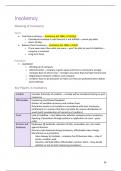Insolvency
Meaning of Insolvency
Event
• Cash flow insolvency – Insolvency Act 1986, s.123(1)(e)
o Considered insolvent if cash flow test is not fulfilled – cannot pay debt
o Given 10 days
• Balance sheet insolvency – Insolvency Act 1986, s.123(2)
o If one owes more than what one owns – won’t be able to meet its liabilities –
company is insolvent
o Long term focus
Procedure
• Liquidation
o Winding up of company
o Administration – company is given space and time to restructure and get
company back to what it was – stronger assurance that you’ll get money back
o Negotiations between creditors and company
o Creditors have to be proactive to make sure they are protected when debtor
goes bankrupt
Key Players in Insolvency
Creditor Consider hierarchy of creditors – remedy will be considered during or post
insolvency
Officeholder Insolvency practitioner/liquidator
Gathers all available resources and realises them
Distributes assets to all creditors in accordance with their insolvency
entitlement in a manner that does not allow for uneven distribution of
assets (with consideration of hierarchy of creditors)
Court Look at cashflow – must determine whether company enters insolvency
Opening of procedure through petition or application to court – gives
order
Director and Employees (& landlords, retention of title, receivables, etc.) can claim
Employee against directors
Directors take backseat during insolvency, officeholder takes charge
Moratorium as a procedure
- Gives leeway to mistakes – company has 20 business days – stay of
action, creditors wait
- Directors still hold office, Officeholder monitors them – they decide
whether or not to start insolvency procedures
56





